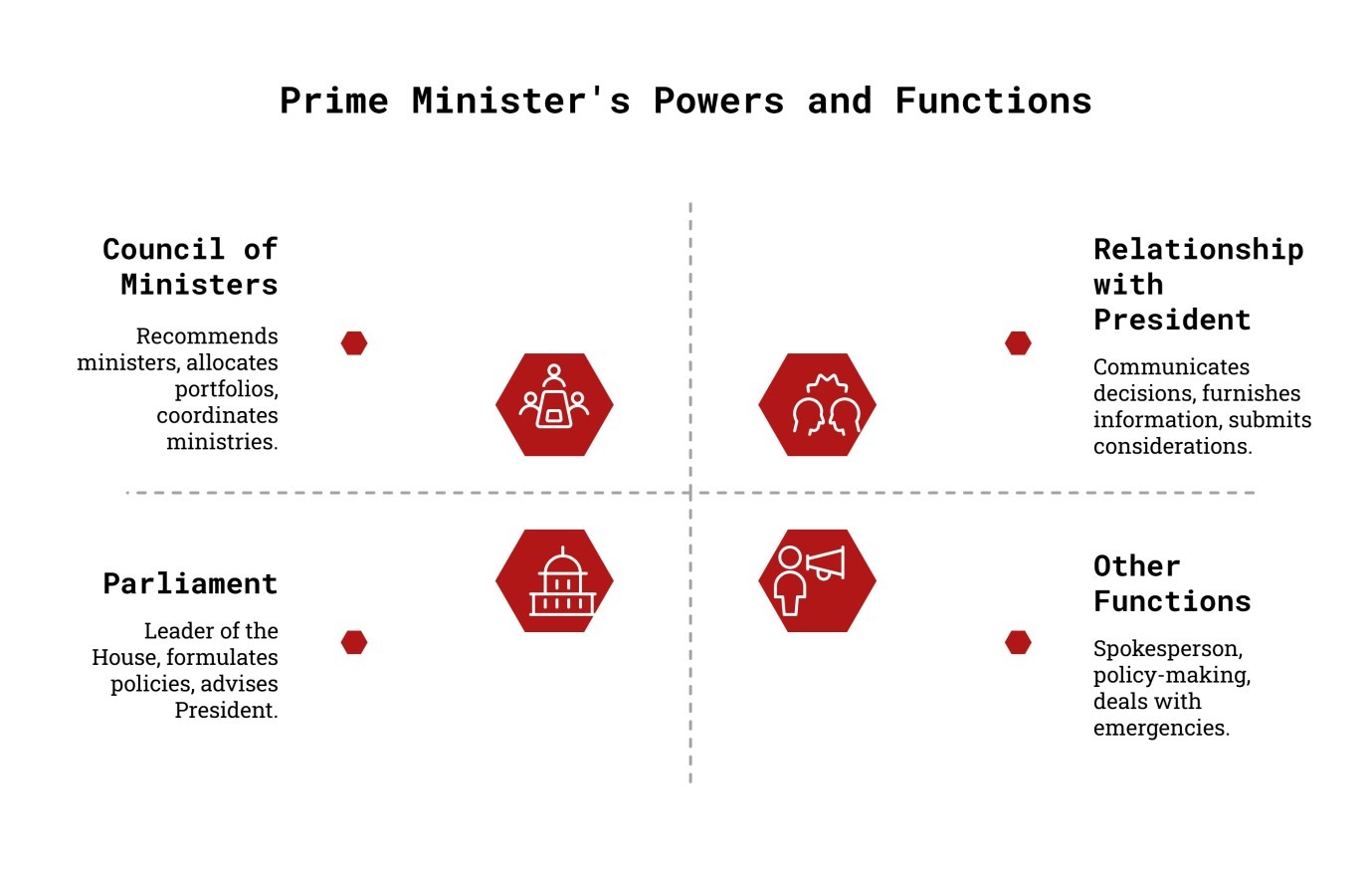Prime Minister
The Prime Minister holds a very significant position in the governance structure, being the head of the government. This makes their role analogous to that of the Chief Minister at the state level. The Governor is the nominal head of the state, while the Chief Minister is the real executive authority. Similarly, at the central level, the President is the head of state, and the Prime Minister is the head of the government.
Appointment of the Prime Minister
The President appoints the Prime Minister. However, the President’s discretion in this appointment is usually limited. According to well-established parliamentary convention, the leader of the majority party in the Lok Sabha (House of the People) is appointed as the Prime Minister. If no single party secures a clear majority in the Lok Sabha, the President may use their discretion to appoint a Prime Minister who, in their judgment, is most likely to command the confidence of the majority in the House. This could involve inviting the leader of the largest party or a leader who has the support of a coalition of parties.
It is important to note that the Constitution does not specify a fixed procedure for the selection and appointment of the Prime Minister. Article 75 merely states that the Prime Minister shall be appointed by the President.
Oath, Term and Salary
Before assuming office, the Prime Minister takes an oath of office and secrecy. The oath of office pledges allegiance to the Constitution and faithfulness in the execution of duties, while the oath of secrecy binds them to maintain confidentiality of information.
The Prime Minister’s term is not fixed by the Constitution. They hold office during the pleasure of the President. However, this ‘pleasure’ of the President is generally conditional on the Prime Minister continuing to enjoy the confidence of the majority in the Lok Sabha. If the Prime Minister loses the support of the majority, they are expected to resign, and if they do not, the President can dismiss them.
The salary and allowances of the Prime Minister are determined by the Parliament from time to time. They receive the same salary and allowances as a member of Parliament, in addition to certain perquisites as the head of the government.
Powers and Functions of the Prime Minister
The Prime Minister wields significant powers and performs crucial functions in the Indian political system:
- Council of Ministers: The Prime Minister recommends to the President the persons who can be appointed as ministers. They also allocate portfolios among the ministers and can ask a minister to resign or advise the President to dismiss a minister. The Prime Minister presides over the meetings of the Cabinet and influences its decisions. They also coordinate the work of different ministries. If the Prime Minister resigns or dies, the entire Council of Ministers stands dissolved.
- Relationship with the President: The Prime Minister acts as a vital link of communication between the President and the Council of Ministers. Article 78 specifies the duties of the Prime Minister in this regard. The Prime Minister communicates to the President all decisions of the Council of Ministers relating to the administration of the affairs of the Union and proposals for legislation. They also furnish such information relating to these matters as the President may call for. If the President so requires, the Prime Minister submits for the consideration of the Council of Ministers any matter on which a decision has been taken by a minister but which has not been considered by the Council.
- Parliament: The Prime Minister is the leader of the House (Lok Sabha). They play a significant role in formulating and implementing the government’s policies and legislative agenda in Parliament. They can advise the President with regard to the summoning and proroguing of the sessions of Parliament and can recommend the dissolution of the Lok Sabha to the President.
- Other Functions: The Prime Minister is the chief spokesperson of the government and represents the country at various international forums. They play a crucial role in planning and policy-making at the highest level. The Prime Minister also deals with various national emergencies and crises.

Role Descriptions
The Prime Minister’s role can be described in several ways highlighting their central position:
- Head of Government: As mentioned earlier, they are the chief executive and the head of the Council of Ministers.
- Leader of the Majority Party: They typically lead the party that commands a majority in the Lok Sabha.
- Chief Policy Maker: They play a pivotal role in formulating the policies of the government.
- Crisis Manager: They often take the lead in handling national crises.
- Link between President and Cabinet: They facilitate communication and coordination between the President and the Council of Ministers.
Relationship with the President
The relationship between the Prime Minister and the President is based on the principles of parliamentary democracy. While the President is the nominal executive head, the Prime Minister is the real executive head who exercises most of the executive powers. The President generally acts on the advice of the Council of Ministers headed by the Prime Minister. However, the President does have some constitutional and situational discretions. For instance, in case of a hung parliament, the President has discretion in inviting a Prime Minister. Also, the President can ask the Council of Ministers to reconsider its advice.
Chief Ministers who became Prime Ministers
Interestingly, several individuals who previously served as Chief Ministers of their respective states went on to become the Prime Minister of India. This demonstrates the experience and political acumen gained at the state level can be valuable in leading the national government. The source does not provide a list of these Chief Ministers.
It’s important to understand that the Prime Minister’s office is central to the functioning of the Indian government, wielding considerable power and responsibility in shaping the nation’s policies and direction.
